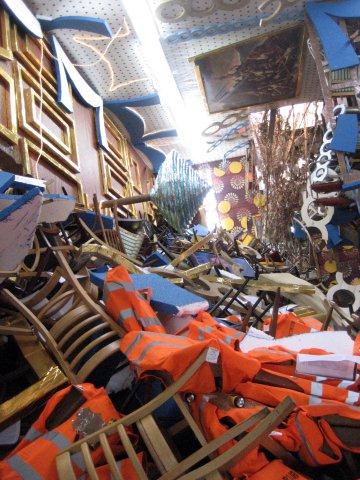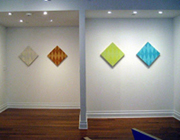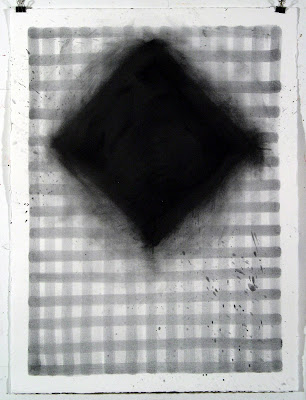Well, not these rules. I'm talking about the understood concepts that make the art world run more smoothly, or which provide an easier path for you to travel within it. Image from the Internet
.
.
In a small gallery in Tribeca in the early 90s, a
panel-discussion with four gallery directors took place on a weekday evening.
It was billed as an event “for mid-career artists.” Fifty or so artists were
expected. About 200 showed up, waiting in a line that stretched around the
block. The age range spanned seven or eight decades. All were looking for the advice
that would send their careers soaring.
.
After each of the dealers talked about their gallery protocols and
how they find artists, one of the older artists rose and said something like,
"In art school I learned that success would come at midcareer, so I waited
my turn. But now I find that the younger artists have moved to the head of the
line." He was angry.
.
A panelist responded kindly: "Times have changed. What you
learned in art school about getting shown and finding a gallery no longer
applies. One of the reason younger artists are meeting with success sooner is
that they aren't operating under the 'old rules.' They don't know what those
'rules' are. You can't rely on the rules that you followed 20 years ago. Or even
10 year ago.”
.
“Well,” he demanded, “what are the rules?”
.
Advance the discussion by two
decades. Artist Rob Tarbell emailed recently with the same question: “What are the unwritten rules of the
art world? Do they differ by city or region? Do they differ by gallerist,
curator and artist?”
.
This is a job for crowd sourcing—I hope you’ll all
comment below—but let me start off with
a general comment. I think there are subtleties from region to region and,
personalities being what they are, from dealer to dealer, or curator to curator
whatever the region. For instance, there’s a well-respected dealer in Portland, Maine,
who is totally open to having you call and ask, “May I bring in some work to
show you?” Try that with a New York
dealer, and you won’t get past, “Hello.” On the other hand, a new curator even
from a major city, is likely to be more open to looking in the early days of
her tenure, while she’s assessing the art community and the artists in it.
.
Here are some “rules” that do seem to apply pretty much
across the board. I’ve culled them from previous Marketing Mondays posts, informal conversations with art world friends, and a check of my trusty
reference tomes, The Artist’s Guide, Art/Work,
and How to Start and Run a Commercial
Gallery..
.
1. Do your homework
One of the threads that runs through the four years of this
column comes from dealers and curators: To find the gallery that’s right
for you, you have to eliminate all the ones that are not. That requires time spent visiting
galleries, going to openings, and following the galleries’ exhibitions online when you
can’t visit them in person. You can call it reconnaissance, homework, or visiting the galleries with a purpose. .
.
Heather Darcy
Bhandari and Jonathan Melber, authors of Art/Work,
call this “The One Year Rule.” Their advice: “Follow a gallery’s program for
about a year before you even think
about asking a gallery to look at your work.”
.
Here’s Edward Winkleman, owner of the Winkleman Gallery in Chelsea, blogger, and author of How to Start and Run a Commercial Gallery, in a 2007 blog post that remains as
timely now as it was then: “Understand what your potential market is like
and find the galleries that target that market. This takes work and research
but will pay off your entire career.”
.
2. Dealers are always
looking even if they tell you they're not
Most gallery websites post a “We are not currently accepting
submissions” disclaimer (reason: Not enough artists do their homework, Rule #1), but they
are always looking. A Midwest art dealer I talked to for How Dealers AreConsidering Artists Now, a Marketing Mondays post from 2009, says this about how and where they look: “The
order has changed: One, recommendations from other artists who know me, my
program, and the artist they are recommending; two, discovery as I travel to art
fairs and,
sometimes, other galleries; three, unsolicited submissions, about
one in a million.”
.
3. You will be
rejected
“No matter how renowned, well-connected or talented, everyone
will get rejected from opportunities they want,” writes Jackie Battenfield, artist and author of The Artist’s Guide. Knowing this doesn’t
lessen the hurt, but it does put you in good company. Battenfield’s mantra: “If
I’m not being regularly rejected, it means I’m not pursuing opportunities.”
It took me years to even be able to talk about my first rejection, but what I learned ultimately is that I ceded far too much power
to that turndown. It was one dealer’s response to a small body of work on
one particular day.
.
4. Be professional
This seems too simple to be a "rule" but professionalism is a prime directive in business, and the showing and selling of art is a business. All things being equal, your complete package,
timely delivery, positive attitude, good humor, and willingness to work with a dealer or collector will get you more of what you want and need. Conversely, the diva/o who makes everyone's job more difficult, or the guy who writes the mean blog and insults everyone on Facebook are cutting themselves off from whatever opportunities might have come their way. .
.
5. Represented by a
gallery? Don’t sell out of your studio
A dealer, interested in the work of a particular artist, did
his due diligence. What he found: the artist’s reputation of selling out of his
studio while represented was true. The dealer did not extend an invitation for
representation. The full story is here.
.
Ed Winkleman says this very clearly in his book: “So much of the relationship between an
artist and a dealer is based on trust. Nothing tests that trust more that the
questions surrounding an artist selling his work directly out of his studio."
.
6. Keep one set of
prices, wherever you’re selling
If you’re a represented artist who sells during an open
studio, or if you're an unrepresented artist who sells in a variety of venues, from group shows in commercial galleries, to solos in non-profits, to open studios, keep the same
price list. You may make more or less depending on the situation (and you can extend a discount if necessary), but you don’t
want collectors seeing your work at a lower price in one venue, higher at
another.
.
Here are Bhandari and Melber: "Make sure your prices are consistent in all the venues showing your work. This is important for several reasons: you don't want collectors bargaining over your work, you don't want dealers competing over prices, and because it's customary for prices to be consistent, it looks like something is wrong when they aren't."
.
Corollary: Everyone asks for a discount. Make sure your price
is set to accommodate the standard 10% “courtesy.” The discount is also a way for your galleries in smaller geographic locations to sell at your New York City (or any large city) price.
.
7. It’s not easy for
any artist to find or make a place in the art world, but it’s easier for men
We all know the statistics: More women than men attend art school; in the galleries, and especially in museums, the numbers flip dramatically. In art sales, too, the selling prices are higher for men. It may be hard to sympathize when a Cady Noland goes for $6.6 million, but here's "S.T.", writing on The Price of Being Female in the blog, Prospero: "Indeed, depictions of women often command the highest prices, whereas works by them do not."
..
Are there exceptions, yes?
But the rule is what's weighing us down.
.
Corollary: Ageism. Even for the men. Just wait.
.
8. Vanity Galleries
are the kiss of death
Vanity—aka pay-to-show—galleries bank on the rejection
so many artists face in finding a commercial gallery to represent them. But if you pay
up front to show, the gallery has no incentive to actually sell your work, and
certainly no interest in nurturing and developing your career. The opinion of most
professionals: Stay away. I wrote about them here in 2008, and artists are still commenting.
,
Here’s Jackie Battenfield in The Artist's Guide, on pay-to-shows: “They are not career builders. Reputable
galleries do not charge the artist for shows. Your art will be better served if
you spend your time and money looking elsewhere.”
.
Corollary: Artists' co-op galleries are an entirely different species. Knowing
that all galleries will not find commercial representation, artists in co-op galleries, which are maintained by membership dues, work to maintain standards by
jurying new members and seeing that all members adhere to co-op rules. The artists are co-operative owners. Moreover, some
artists prefer the freedom of a co-op to show work that is not commercially
viable. (The whole truth: In a city like New York, they are generally lower on the food chain. But consider that a good co-op with a long history of experienced management and good exhibitions has more currency that a commercial gallery that's opened by a novice and gone in a season.)
.
9. The taint of
“careerism” is past. It’s OK to self promote (but venture outside the undefined parameters and you’re an annoyance)
Many midcareer artists are still laboring under the benighted
concept that promoting themselves tarnishes their integrity and ruins their
art. Several decades of art school professors willfully or ignorantly promoted
those ideas. But it’s a new millennium.
So, websites, blogs and business cards: Fine. Postcard announcements of an exhibition
or other big career event: Fine.
A quarterly or monthly newsletter: Fine, as
long as you offer an unsubscribe option. Daily “Sold!” updates on Facebook: Annoying. And
I think you know the verdict on those endless Tweets detailing every career move.
Rule of thumb: If someone else does it and you find it annoying, it will be just
as annoying if you do it.
.
Apropos
of exhibition postcards, Valerie McKenzie, whose McKenzie Fine Art is newly
located on the Lower East Side, whom I quoted in a blog post on Self Promotion, suggests you
distribute those announcement cards judiciously in certain instances: "I discourage the
obnoxiousness of handing out your own announcement card at someone else's
opening! "
.
10. Two words:
Professional courtesy
So much of the art world runs on reciprocity. Courtesies extended to another are then returned it in kind or in a
related way: referrals, advice, reference letters, mentoring and more. My friend Susan is a great example of how reciprocity works. A midcareer
artist with a long resume, she understands how to network and she has the
contacts to do it well. Because she’s secure in her career, she knows that
sharing information or recommending someone will not diminish her achievements.
On more than one occasion she has given my name and website to one of her
dealers. I have done the same for her. Result: I’m with a gallery on her
referral, and she on mine. We’ve each expanded our careers that much more by
the simple act .of mutual support. Read more here.
.
11. Rules change: DIY
is no longer a career killer
Indeed, it's a badge of respect. The idea of artists taking control of their careers
has never been stronger. Exhibitions, publications, blogs, and curatorial projects are
being undertaken by artists for themselves. Want a solo? Find a space and have
one. Have an opinion? Write a blog. It helps if you’re savvy about the system and can self-promote well, but
doing it yourself has all kinds of permutations and possibilities. Indeed, many
artists are hyphenating—to artist-gallerists, artist-curators, artist-critics,
even artist-art fair organizers. I wrote an extensive post here.
.
I believe the newfound respect for DIY has to do with art-world folks—dealers, independent curators (many newly independent as a reult of institutional downsizing) and writers (many freelancing as opposed to on staff)—who are struggling since 2008 in a way that many had not struggled before. "When I see what artists do for themselves, I am in awe," said a dealer to me just after the 2008 crash. (Then he asked if I knew of any jobs.) More here.
12. Some rules don't change: It really is about the work
Galleries have their programs, museum have their protocols,
and critics have their point of view, but the bottom line is this: It’s about
the work, for the artists who are laboring in their studios, and it’s about the
work for those who are considering it. Yes, the physical persona of the artist helps,
especially in a beauty-conscious, youth-obsessed, boldface-name culture, but the
work still has to speak for you and to the person who is viewing it.
.
Corollary: Don’t assume
the work will speak for itself. Be prepared to advocate on its behalf. When Barbara O’Brien, now director of the
Kemper Museum in Kansas City, Missouri, spoke a few years ago at an event I’d organized,
one of the comments that stayed with me was the idea that the making of your
work, essential as it may be, is helped immensely by you, the artist, in
speaking or writing clearly about it and presenting it well.
.
Over to you. What rules would you add to this list?
.
If you have found this post helpful, please
consider a voluntary annual donation of $20 to support this blog. Scroll down
the sidebar from the top to find the Paypal link. Thank you. And big, big thanks
to all the readers who have done so already!







.JPG)



















































